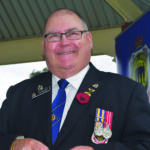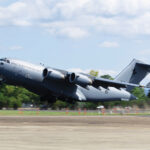A
fter nine long years “Val” is back where she belongs. When the gathering “storm clouds” of the Second World War became threatening, Australia started once again to look to its defense. The first Menzies’ Government came to power in 1939 and set in place events leading to the establishment of an ammunition fill for Australia and St Marys was chosen because the road and rail links were reasonably good, and land to the north was relatively cheap and sparsely populated and there was a good manpower supply available in Parramatta, Sydney and the Penrith District. The now defunct Encore Historical Sewing Group decided we would sew a replica of the women’s uniform that was worn at the ammunition filling factory at St Marys, so in September 2009 an attempt was made to start on this project. By 2013 the project was finished and our “Val” was placed in a glass cabinet and put into the St Marys Library, but due to the upcoming changes at the library a year later she was moved to Penrith Library Research Room where she stayed until October this year. I asked for help from a very high official so that “Val” could be returned to her rightful place at St Marys, things started moving. Members of the sewing group decided in 2009 on re-creating a replica of the uniform worn by the women workers at the munitions site and we all agreed that it would be an excellent project for the group, so we set about gaining more information about the uniform via research and photos, as well as dialogue from some of the women we knew that had worked at the munitions during the 1940’s and 50’s. In February 2010 the members were delighted when we found out that we were successful in gaining CAP funding from Penrith Council for the re-creation of the uniform. A lady named Margaret Dunn who worked at the munitions for 25 years said she was happy to help us out with details of the uniforms that were made of heavy black flannel material, baggy long trousers with a drawstring waist, a white blouse and a black jacket made of the same fabric as the trousers. The women workers wore black berets, and the women Charge Hands wore grey berets as well as a black arm band with a “C” emblem on it for “Charge Hand” and their shoes had wooden tacks. All the women’s jewellery, including wedding bands had to be removed before work began as they could cause sparks. We didn’t realise at that time just how much time and research it took up with finding everything needed to make the uniform, but the members were confident that we could sew the uniform and make it as authentic as possible, so we all took up different tasks to find out just what was needed. It was also suggested that we check our private collection of old buttons for navy coloured bone buttons and contact was made with “All Buttons Great & Small” regarding leather buttons asking them to send out samples. A lady called Val Stirton had also been most helpful as she said she worked in the supply office where the women were given their uniforms. She said she worked at the Munitions after the war from 1952 to 1977 and the uniforms were still the WW2 issue. She thought everything was wool or maybe even flannel and the underwear was woollen too and that wool was best in the case of fire. The shirt worn was either khaki or white and it had a Chinese collar and no cuffs, and it was cut as just a straight piece of fabric with sleeves and a drawstring at the neck. Shoes were leather with leather sprigs, and they were tan in colour. They wore a black “snood” to cover the hair. All buttons were leather, and the trousers were made with a front flap and did up each side with a button and loop and underwear was supplied and the bra had bone fittings and they wore cotton socks. Val said that in the change room they put their good clothes on a hook until knock-off time and workers in the TNT part of the munitions had to shower after every break. After hearing from “All Buttons Great & Small” who didn’t have the buttons, we contacted a place in the UK for the leather buttons we needed, and they sent them to us. In February 2011 we received another successful CAP funding from Penrith Council for the purchase of an ex-rental mannequin and we decided to name her “Val” after Val Stirton. Finally in November 2011 measurements were taken for the making of the glass cabinet to house “Val”. In 2012 Councillor M.P., Tanya Davies and Mayor Greg Davies were invited to see “Val” all dressed up in her full ADI uniform and to discuss our issues on where “Val” will be housed. After five years we finally requested that she was put into a glass case and into the St Marys Library closer to where those women would have worked, and also because of the history of the St Marys area. So you can see that a lot of different information and a lot of confusion had taken up a great amount of the members time, as well as personal sickness, holidays and family problems and Covid, but keep in mind that we found ourselves delving into an area that has little information available– with black & white photographs and conflicting information about the uniforms, as well as a time span of 60 years!! We tended (not deliberately) to gravitate towards projects that challenge and take a few years of research and hard work to come to fruition! But we ALWAYS got there in the end! A book on this project is available for sale at $10+postage. There is also a book on the Ammunition Filling Factory for sale at $15+postage. Contact me on (02) 8840-8771 or email the St Marys Historical Society at stmaryshist@gmail.com.






